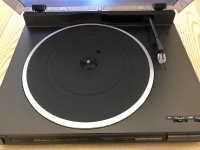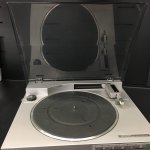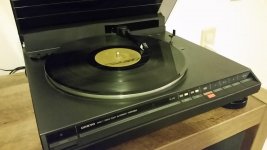What would be the downside of a cheap spring? The weakening seems to be one of them, due to the mechanical stress of the steel.
But in my particular case, it would seem that over time it has become more rigid instead of weakening ...
Being familiar with many types of TT, VPI is one of the brands that I did not have access to, and I did not know that the anti-skid force is actually exerted by the shape and resistance of the arm cable.
I always thought those cables were too thick !!! Here's why ...
Opposing Forces: The Ins and Outs of Anti-Skate — Vinyl Me, Please
But in my particular case, it would seem that over time it has become more rigid instead of weakening ...
Being familiar with many types of TT, VPI is one of the brands that I did not have access to, and I did not know that the anti-skid force is actually exerted by the shape and resistance of the arm cable.
I always thought those cables were too thick !!! Here's why ...
Opposing Forces: The Ins and Outs of Anti-Skate — Vinyl Me, Please
they might need some sort of steely alloy for those cables to act the same over time and there are actually lots of tungsten copper wires used in the automotive and speaker industry...good idea actually.I might take it into account for my future tonearms.
I have not seen tungsten applications on the speakers.
Could you clarify the point?
Perhaps you mean the flexible cables that connect the VC to the terminal blocks, accompanying the movement of the cone, they are a mixture of beryllium and copper.
Tungsten - Wikipedia
Beryllium - Wikipedia
Could you clarify the point?
Perhaps you mean the flexible cables that connect the VC to the terminal blocks, accompanying the movement of the cone, they are a mixture of beryllium and copper.
Tungsten - Wikipedia
Beryllium - Wikipedia
you may be right...never really looked for the actual composition of the wires i find in the usual industrial equipment i fix, i just see they are much more tough to flex than usual and kind of the same composition as automotive wires which needs to withstand higher temperatures and vibrations.Some audiophile companies offer tungsten wire for speakers, but i can only rely on google for information.
I can only imagine a place in the whole construction of an electrodynamic speaker that uses some cable of flexible material, good conductive and without memory effect.
They are the ones that join the ends of the voice coil to the connection posts. They must accompany the movement of the cone for thousands of times in its entire useful life.
At the risk of being wrong, I believe that braided beryllium is the traditional method for prestigious brands, and in descending order, an alloy with copper, all the way to cheap braided copper speakers only.
Surely the experts will correct me, welcome.
Regarding the unipivot and AS system through the cartridge connection cable, I think VPI is not the only one. This is a difficult subject, there are opinions for all tastes, it is even said that in a unipivot system it is not necessary to use AS ..... I do not share that.
For VPI Unipivot Owners, do you use antiskating? | Audiogon Discussion Forum
They are the ones that join the ends of the voice coil to the connection posts. They must accompany the movement of the cone for thousands of times in its entire useful life.
At the risk of being wrong, I believe that braided beryllium is the traditional method for prestigious brands, and in descending order, an alloy with copper, all the way to cheap braided copper speakers only.
Surely the experts will correct me, welcome.
Regarding the unipivot and AS system through the cartridge connection cable, I think VPI is not the only one. This is a difficult subject, there are opinions for all tastes, it is even said that in a unipivot system it is not necessary to use AS ..... I do not share that.
For VPI Unipivot Owners, do you use antiskating? | Audiogon Discussion Forum
" VPI has conducted careful listening tests and determined that every tonearm they tried sounded better with its mechanical anti-skating disabled and the tracking force very slightly increased... "
https://elusivedisc.com/vpi-anti-skate-device-for-jmw-9-tonearms/
https://elusivedisc.com/vpi-anti-skate-device-for-jmw-9-tonearms/
it seems they don't sell tangential tracking tonearms so they preffered to sell some "slightly" wearing vinyl tonearms 🙂
Linear tracking arms are extremely complex if you want them to outperform a conventional tangential one. You have to accompany them with an auxiliary optical arm that sends the order to an electronic circuit that in turn sends the order to the mechanical system so that it moves exactly accompanying the advance of the furrow.
It would be interesting to see what happened if someone did some measurement / comparison of the distortion inherent in each system, linear vs. tangential.
I never saw that, which is not to say it wasn't done .....
Bang & Olufsen Beogram 4000 Tangential record player - YouTube
It would be interesting to see what happened if someone did some measurement / comparison of the distortion inherent in each system, linear vs. tangential.
I never saw that, which is not to say it wasn't done .....
Bang & Olufsen Beogram 4000 Tangential record player - YouTube
And when you had to change the needle (which was unique for that TT), prepare yourself for a very large expense.
The incompatibility with other cartridges I think made them even more unpopular than their complexity......😱
Technics SL-L20 Linear Tracking Turntable Service - Audio Appraisal
The incompatibility with other cartridges I think made them even more unpopular than their complexity......😱
Technics SL-L20 Linear Tracking Turntable Service - Audio Appraisal
Attachments
This is an engineering masterpiece! The good old days ! 😀
Dual 78 rpm record changer. Record sizes can be mixed 10" or 12".
It plays 10 records. A crystal stylus is used.
Dual 1001 Vintage Record Player - YouTube
Electric Gramophone - Phonograph
Dual 78 rpm record changer. Record sizes can be mixed 10" or 12".
It plays 10 records. A crystal stylus is used.
Dual 1001 Vintage Record Player - YouTube
Electric Gramophone - Phonograph
I fixed an old Dual amplified with ecl86 two weeks ago...not as old as yours but still...spring loaded tonearm...as for tangential trackers, Rabco tonearms principle might simply be the simplest that work well enough.
I did not know him, reading!
Rabco SL-8E SL-8: Tangential Tonearm, Servo Control, Parallel Tracking, Functioning, Drawings, Construction, Manual.
Thanks !
Rabco SL-8E SL-8: Tangential Tonearm, Servo Control, Parallel Tracking, Functioning, Drawings, Construction, Manual.
Thanks !
I was thinking that maybe it would be much more useful if vinyl lathe would have a pivoting 9 inch arm too so that the most used 9 inch arm found in regular turntables could read the records without errors...
The long length of exposed cabling from the headshell in the Rabco looks rather like a hum generator. It reminds me of the Souther linear arm which also has an excess of unscreened signal wires. Sort of makes a phono preamp with balanced inputs mandatory, or an owner / listener who likes a little hum and noise with their music.
fortunately the hum isn't really excessive with fairly long exposed cables and you can twist them too...i have a tonearm with about 30cm of exposed wires and the hum is kinda low...
johnmath,
As a modifier and user of Rabco SL-8E’s I take exception to your insinuation that I am “an owner / listener who likes a little hum and noise with their music.” The signal wires from the carriage to the RCA jacks in the base are screened. Whatever hum might exist is below the noise floor of my vinyl. I can’t comment on the Souther as I’ve never owned one. Are you speaking from experience or speculation? And what does this have to do with anti-skating?
Ray K
As a modifier and user of Rabco SL-8E’s I take exception to your insinuation that I am “an owner / listener who likes a little hum and noise with their music.” The signal wires from the carriage to the RCA jacks in the base are screened. Whatever hum might exist is below the noise floor of my vinyl. I can’t comment on the Souther as I’ve never owned one. Are you speaking from experience or speculation? And what does this have to do with anti-skating?
Ray K
Linear tracking tonearms have nothing to do with antiskating, but keep popping up in the thread. But defending hum in a turntable - that's something that came out of left field.
Being the author of the thread, I do not care, go ahead, this thread is very interesting because it is available to those who do not want mathematical calculations, but concepts understandable by many that I bet have not even seen / had an automatic LP changer in their life.
I did not know him, reading!
Rabco SL-8E SL-8: Tangential Tonearm, Servo Control, Parallel Tracking, Functioning, Drawings, Construction, Manual.
Thanks !
That article is very good !🙂
Has it been pointed out yet that no linear tracking tt can compete with a pivoted design in sq except for the air bearing type?
- Home
- Source & Line
- Analogue Source
- How accurate are anti-skating systems ?


